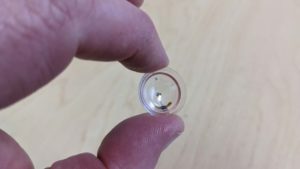Mojo AR contact lenses hands-on: A new way to look at the world
How Mojo’s lenses work
Unlike soft contact lenses that are made of flexible plastic, the Mojo lenses are rigid gas permeable lenses that rests on the sclera — the white of your eye — forming a vault over your cornea.
The lenses are specifically designed for the specific topology of the wearer's eyes. That way, Sinclair said, they don't rotate or slip during the day, keeping the display embedded on the Mojo lens pointed at your fovea, where the center of your field of vision is found.

This required customization explains why the demos I used at Mojo's Saratoga, Calif., headquarters featured VR headsets and exterior lenses, rather than the extensive fitting needed for a pair of contact lenses.
The current version of Mojo's lenses feature oxygenation, which allows the company's employees and testers to wear the lens for extended periods. (Sinclair says it's quite comfortable.) The future version, in addition to adding a battery, will have a higher-resolution display, motion sensors for tracking eye movements, and an image sensor that can see what you're seeing, for computer vision purposes. In other words, the lenses will be able to recognize the objects you're looking at and bring up contextual information.
For now, the work at Mojo is going to focus on efforts to shepherd the contact lenses through the FDA-approval process now that the basic idea behind these AR-powered devices looks solid.
"We're wearing them. We see content. We know that it's not a matter of if now, it's just a matter of when and proving the safety and efficacy so the FDA certifies it," Sinclair said.
See the full story here: https://www.tomsguide.com/hands-on/mojo-ar-contact-lenses-features-specs
Pages
- About Philip Lelyveld
- Mark and Addie Lelyveld Biographies
- Presentations and articles
- Tufts Alumni Bio
